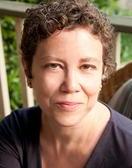Over the past seven years, in over 300 posts, I have written about many different aspects of Rosh Hashanah and Yom Kippur, from the context of an interfaith family. Here is one of the most popular essays from that collection. –SKM

When we experience the religious rituals of the “other,” we usually cannot help but respond with an internal running commentary, seeking connections to our own past. I know that whenever I heard the blast of a conch shell at an Afro-Brazilian rite during my years in Brazil, my mind would skip back to the sound of the shofar in my childhood temple.
On Rosh Hashanah and Yom Kippur, many Christians (and Muslims, Hindus, Buddhists, atheists) find themselves attending services with Jewish partners, or parents, or other family members. These services, while tremendously important to Jews, can be difficult for those without Jewish education to access, due to length, solemnity, and the density of Hebrew. Nevertheless, I always strongly recommend that those of other religions accompany their Jewish partners or parents to synagogue services, both to keep them from feeling lonely, and to learn and reflect.
In our Interfaith Families Project, a community of interfaith families raising children with both Judaism and Christianity in Washington DC, we have the great fortune to have annual High Holy Day services led by Rabbi Harold White, a rabbi who spent 40 years in a Jesuit environment at Georgetown University. Recently, he shared some interfaith interconnections to look for on Rosh Hashanah and Yom Kippur:
- Awe. Since the highest of holy days in Judaism is actually the weekly Shabbat, many rabbis prefer the term “The Days of Awe” to describe Rosh Hashanah and Yom Kippur. Think of awe not as fear, but as a mystic trembling meant to “stir up divine sparks.” Rabbi White compared the swaying of Jews at prayer (known in Yiddish as shuckling) to the quaking of Quakers and the shaking of Shakers. Rhythmic body movement during prayer, whether it’s dancing or repeated bowing, occurs in virtually every religion, from Africa to Asia to American Indian traditions: the mind and body come together, self-consciousness falls away. Says Rabbi White, “Evangelicals have the right idea on this, with hands thrown up in the air.”
- Mystical numbers. Yom Kippur marks the end of an annual 40-day spiritual quest in Judaism. All three Abrahamic religions share an obsession with the number 40, which Rabbi White describes as “a magical number in the Middle East. Moses was on Sinai for 40 days, Jesus was in the desert for 40 days, even Ali Baba and the 40 thieves. You think it’s a coincidence. It’s not.”
- Asking for Forgiveness. The liturgy of Rosh Hashanah and Yom Kippur hinges on the idea that all of us have sinned. “I know that sounds very Christian, but it’s very Jewish at the same time,” says Rabbi White. “There is no one on the face of the earth who hasn’t sinned.”
- Praying for Material Well-Being. For most of the year, Jewish prayer focuses on praise and adoration, rather than petition. Asking for direct intervention tends to be more closely associated with Christian prayer. But Rosh Hashanah is the exception, when Jews pray for health and life. “We don’t ask for anything the rest of the year,” says Rabbi White. “But on the Days of Awe, we ask.”
- Birth of Three Faiths. On Rosh Hashanah, the Torah reading describes the arrival of Abraham’s two sons: Sarah gives birth to Isaac, Hagar gives birth to Ishmael. Sarah becomes the matriarch of Judaism (and thus Christianity), Abraham sends Hagar into exile. But in Muslim writings, the heroic Hagar (Hajir) becomes the mother of Islam. Charlotte Gordon (an adult interfaith child) has written a sensitive analysis of the story of Hagar in her book The Woman Who Named God: Abraham’s Dilemma and the Birth of Three Faiths.
- Miracles. Sometimes Jewish students approach Rabbi White and assert, with a certain smugness, that Christianity requires belief in miracles and Judaism does not. The Rabbi points to the miracle of the birth of Isaac, when Abraham and Sarah are in deep old-age (Abraham is 100). Genesis specifies that Sarah not only has suffered from lifelong infertility, but is post-menopausal. Virgin birth, post-menopausal birth, both miracles.
- Songs and Canticles. The Biblical passage known as the Song of Hannah, a reading from the prophet Samuel, is the haftara reading chosen to complement the Torah reading on the first day of Rosh Hashanah. The infertile Hannah has prayed for and been given a son, and her song of Thanksgiving is thought to have inspired the most famous of all canticles in the Christian liturgy, the Song of Mary, known as the Magnificat.
Finding a welcoming service, getting off work, arranging childcare, sitting through services, fasting, gleaning meaning from ancient prayers in an unfamiliar language. None of this is easy, but it is still essential experiential education for any family connected to Judaism. For Jews, having the support of a partner in these days of deep reflection and soul-searching, of repentance and renewal, provides deep comfort and bonding. For interfaith children, having both parents sitting with them at services provides a clear message of respect and appreciation and love, by the parents for each other, and for the children, and for ancient ritual.
Susan Katz Miller is the author of Being Both: Embracing Two Religions in One Interfaith Family, from Beacon Press. She works as an interfaith families consultant, speaker, and coach. Follow her on twitter @beingboth.

